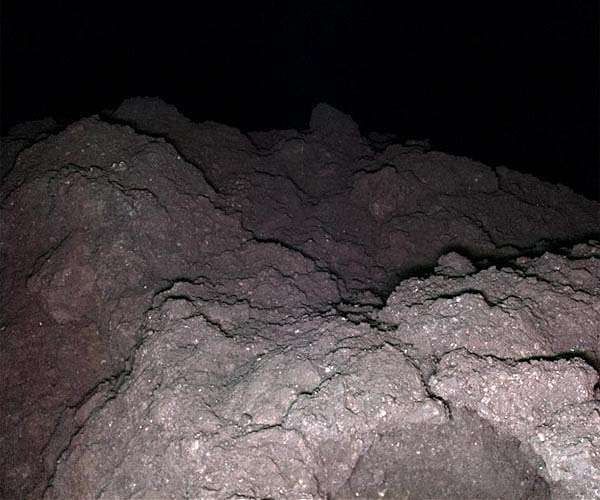
Ryugu be a remnant of an extinct comet (Image Credit: Space Daily)
Asteroids hold many clues about the formation and evolution of planets and their satellites. Understanding their history can, therefore, reveal much about our solar system. While observations made from a distance using electromagnetic waves and telescopes are useful, analyzing samples retrieved from asteroids can yield much more detail about their characteristics and how they may have formed. An endeavor in this direction was the Hayabusa mission, which, in 2010, returned to Earth after 7 years with samples from the asteroid Itokawa.
The successor to this mission, called Hayabusa2, was completed near the end of 2020, bringing back material from Asteroid 162173 “Ryugu,” along with a collection of images and data gathered remotely from close proximity. While the material samples are still being analyzed, the information obtained remotely has revealed three important features about Ryugu. Firstly, Ryugu is a rubble-pile asteroid composed of small pieces of rock and solid material clumped together by gravity rather than a single, monolithic boulder. Secondly, Ryugu is shaped like a spinning top, likely caused by deformation induced by quick rotation. Third, Ryugu has a remarkably high organic matter content.
Of these, the third feature raises a question regarding the origin of this asteroid. The current scientific consensus is that Ryugu originated from the debris left by the collision of two larger asteroids. However, this cannot be true if the asteroid is high in organic content (which will confirmed once the analyses of the returned samples are complete). What could, then, be the true origin of Ryugu?
In a recent effort to answer this question, a research team led by Associate Professor Hitoshi Miura of Nagoya City University, Japan, proposed an alternative explanation backed up by a relatively simple physical model. As explained in their paper published in The Astrophysical Journal Letters, the researchers suggest that Ryugu, as well as similar rubble-pile asteroids, could, in fact, be remnants of extinct comets. This study was carried out in collaboration with Professor Eizo Nakamura and Associate Professor Tak Kunihiro from Okayama University, Japan.
Comets are small bodies that form on the outer, colder regions of the solar system. They are mainly composed of water ice, with some rocky components (debris) mixed in. If a comet enters the inner solar system- the space delimited by the asteroid belt “before” Jupiter-heat from the solar radiation causes the ice to sublimate and escape, leaving behind rocky debris that compacts due to gravity and forms a rubble-pile asteroid.
This process fits all the observed features of Ryugu, as Dr. Miura explains, “Ice sublimation causes the nucleus of the comet to lose mass and shrink, which increases its speed of rotation. As a result of this spin-up, the cometary nucleus may acquire the rotational speed required for the formation of a spinning-top shape. Additionally, the icy components of comets are thought to contain organic matter generated in the interstellar medium. These organic materials would be deposited on the rocky debris left behind as the ice sublimates.”
To test their hypothesis, the research team conducted numerical simulations using a simple physical model to calculate the time it would take for the ice to sublimate and the increase in rotational speed of the resulting asteroid due to it. The results of their analysis suggested that Ryugu has likely spent a few tens of thousands of years as an active comet before moving into the inner asteroid belt, where the high temperatures vaporized its ice and turned it into a rubble-pile asteroid.
Overall, this study indicates that spinning top-shaped, rubble-pile objects with high organic content, such as Ryugu and Bennu (the target of the OSIRIS-Rex mission) are comet-asteroid transition objects (CATs). “CATs are small objects that were once active comets but have become extinct and apparently indistinguishable from asteroids,” explains Dr. Miura. “Due to their similarities with both comets and asteroids, CATs could provide new insights into our solar system.”
Hopefully, detailed compositional analyses of the samples from both Ryugu and Bennu will shed more light on these issues. Make sure to stay tuned!
Research Report: “The Asteroid 162173 Ryugu: a Cometary Origin”
Related Links
Nagoya City University
Asteroid and Comet Mission News, Science and Technology
|
|
Tweet |
|
|
|
We need your help. The SpaceDaily news network continues to grow but revenues have never been harder to maintain. With the rise of Ad Blockers, and Facebook – our traditional revenue sources via quality network advertising continues to decline. And unlike so many other news sites, we don’t have a paywall – with those annoying usernames and passwords. Our news coverage takes time and effort to publish 365 days a year. If you find our news sites informative and useful then please consider becoming a regular supporter or for now make a one off contribution. |
||
|
SpaceDaily Monthly Supporter $5+ Billed Monthly |
SpaceDaily Contributor $5 Billed Once credit card or paypal |
|
Fifth asteroid ever discovered before impact
Paris (ESA) Mar 17, 2022
At 19:24 UTC on 11 March 2022, astronomer Krisztian Sarneczky discovered a bright and fast-moving new object in the sky using the 60cm Schmidt telescope at the Piszkesteto observatory, Hungary. He collected four observations in quick succession, and just 14 minutes later reported his findings to the Minor Planet Center (MPC), initially designating the object ‘Sar2593’.
The results were quickly published and used by automatic impact assessment systems around the world to estimate the possibility of … read more









